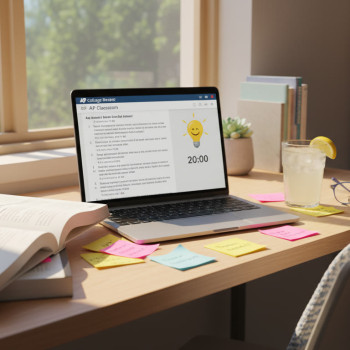The big picture: Why SAT scores still matter — and how that’s changing
It’s easy to feel overwhelmed when you first think about the SAT and international applications. For many Indian students, the SAT is more than a test — it’s a ticket, a metric, and sometimes a stress magnet. But before we get lost in numbers and percentiles, let’s look at the heart of the matter: what SAT scores represent to admissions teams, and how the recent shift to the digital SAT changes the conversation.

Admissions officers use SAT scores as one of many indicators of academic readiness. They’re a standardized snapshot — useful when comparing students from different schooling systems, boards, and countries. But they are not the whole story. Colleges weigh scores alongside grades, essays, letters of recommendation, extracurriculars, and context: the school you attend, the resources available to you, family circumstances, and your personal story.
The transition to the digital SAT adds a new layer: the format is adaptive, the item types are often shorter and more focused, and the testing experience is different. That doesn’t change the purpose of the score, but it does change how students should prepare. Practicing on devices, becoming comfortable with shorter reading passages, and learning time-management strategies for adaptive tests are now essential.
How admissions offices typically use SAT scores for international applicants
When an admissions committee reviews an international applicant from India, SAT scores help them in several specific ways:
- Standardized comparison across curricula: Boards in India (CBSE, ISC, State boards) have different grading patterns — SAT scores provide a common ground.
- Academic readiness signal: Strong scores in Math or Evidence-Based Reading & Writing can reinforce a student’s transcripts and show readiness for college-level work.
- Scholarship and merit decisions: Many universities use SAT scores as a criteria for merit-based aid. A higher score can directly affect scholarship eligibility and award amounts.
- Course placement: Some universities use SAT scores to place students into the right first-year courses, especially in math.
- Supplementing weak areas: If a transcript shows a temporary dip in grades, a solid SAT score can reassure admissions officers about the student’s capabilities.
Important nuance: colleges set their own policies
One detail worth knowing — the College Board creates and administers the SAT, but colleges decide how to use scores. Some schools are test-optional or test-flexible (meaning they may not require SAT scores); others still strongly consider or require them, especially for international applicants. For many selective institutions, a strong SAT score still strengthens an application, even if the school technically doesn’t require it.
What a “good” SAT score means for Indian students applying abroad
Instead of chasing a single “good” number, think in terms of ranges tied to your goals. Different universities and programs have different benchmarks. Here’s a useful way to break it down:
| Score Range (Total) | What it means | Practical implication |
|---|---|---|
| 650–780 | Highly competitive | Strong chance at selective colleges; boosts merit scholarships and STEM program competitiveness. |
| 580–649 | Solid for many good universities | Good fit for many reputable programs; may still qualify for scholarships depending on the school. |
| 450–579 | Moderate | Competitive for less selective schools; consider emphasizing transcripts, essays, and extracurriculars. |
| <450 | Limited but possible | May need to rely more on other strengths, consider retakes, or explore alternative application routes. |
Note: These numbers are illustrative and should be tuned to the specific country and programs you’re targeting. For instance, a 700+ can be essential for top US STEM programs, while many liberal arts colleges have broader ranges.
Scholarships and financial aid: how the SAT can unlock funds
One of the most concrete impacts of SAT scores is scholarship eligibility. Many universities offer automatic merit scholarships tied to SAT ranges. For international students, who often pay higher tuition, scholarships tied to test scores can be a game-changer.
- Merit scholarships: Often automatic when a score falls within a set range.
- Departmental awards: Strong subject-related SAT subscores (like math) can help for scholarships in specific departments.
- Need-blind vs. need-aware: Some schools are need-aware for international applicants — a strong SAT can offset concerns about demonstrated financial need by showing academic competitiveness.
Tip for parents and students: always check each college’s scholarship policies directly. Policies vary widely — some schools will weigh SAT scores heavily for merit aid, while others prioritize holistic factors.
Practical strategy: How to use your SAT score in your application strategy
Your SAT score should inform the college list you build and how you present the rest of your application. Here’s a practical roadmap:
- Set target ranges for reach, match, and safety schools based on recent admitted-student statistics.
- Use SAT subscores to highlight strengths — e.g., a high Math section for engineering programs.
- If your SAT is below target, lean into other elements: stellar essays, impactful extracurriculars, research experience, internships, or strong teacher recommendations.
- Consider test-enhancing strategies like submitting SAT Subject Tests only if relevant (though availability varies), or leveraging AP scores if you have them.
A sample application strategy for a hypothetical student
Meet Anika from Mumbai. She has a strong CBSE transcript, leadership roles in robotics, a summer research project, and an SAT 690 (digital). How might she apply?
- Reach schools: Apply to one or two top-tier STEM programs where her extracurriculars might offset slightly lower SAT percentiles.
- Match schools: Choose several universities where average admitted SATs align with 650–720.
- Safety schools: Pick a couple of universities with averages below 680 that still have good programs and scholarship opportunities.
- Supplemental focus: Emphasize robotics project in essays, secure a teacher recommendation that highlights her problem-solving, and submit an optional portfolio or project link if the program allows it.
Preparing for the digital SAT: what’s different and how to adapt
The digital SAT isn’t just the same paper test on a screen — it’s shorter, adaptive by section, and features shorter reading passages and targeted math questions. Practicing in the right environment is crucial:
- Practice on the official digital testing app or realistic simulators so you’re familiar with the interface.
- Time management changes: shorter items mean pacing can feel faster — get used to that rhythm.
- Focus on device fluency: highlighting text, navigating questions, and using on-screen calculators efficiently.
- Take full-length practice tests under simulated conditions to build stamina and reduce day-of-test anxiety.
For many students, targeted help from an expert tutor that simulates the digital format can accelerate improvement. Personalized tutoring, like Sparkl’s 1-on-1 guidance, offers tailored study plans and AI-driven insights that help students focus on their weakest content areas and adapt to the digital test format more quickly.
How to improve scores efficiently: study advice that actually works
Quality beats quantity. Rather than logging endless hours, prioritize focused, evidence-based practice:
- Diagnose: Take a diagnostic test to identify weaknesses and focus your study plan there.
- Targeted practice: Use short, focused sessions for specific skills (sentence structure, algebraic manipulation, data interpretation).
- Active review: After each practice test, analyze mistakes — what concept, careless error, or timing issue caused it?
- Consistency: Short daily sessions (45–90 minutes) beat irregular marathon sessions.
- Mock test cadence: Take a full practice test every 2–3 weeks and increase frequency as test day approaches.
Parents: support matters. Creating a calm, consistent study routine, encouraging healthy sleep and nutrition, and helping find the right tutoring match can change the preparation experience from stressful to empowering.
Test day and logistics for students in India
Digital delivery affects logistics: some international test centers may require you to bring your own device or use a College Board-provided device if available. Check registration details early.
- Register early — seats in popular months fill fast.
- Know the device policy at your center; practice on a similar device.
- Arrive well-rested: cognitive performance improves dramatically with good sleep and breakfast.
- Time zones and timing: pay attention to test start times and local center rules.
Retake strategy
Retaking the SAT can be a smart move if you use the interim to work on specific weaknesses. A targeted 6–10 week plan focusing on one or two subscores (for example, problem-solving speed or evidence-based reading) often yields better returns than unfocused study.
What about universities that are test-optional?
Many schools offer test-optional policies which can be confusing for international applicants. Test-optional doesn’t mean test-irrelevant. For Indian students applying abroad:
- If your SAT strengthens your narrative (e.g., it’s higher than the norm for applicants from your board), submit it.
- If your SAT score doesn’t reflect your abilities but other parts of your application are strong, you can choose not to submit it — but be strategic and honest about whether other evidence compensates.
- Some scholarships and program placements still rely on scores even if admissions are test-optional. Don’t assume optional means unimportant for financial aid.
Real-world examples: how scores influenced outcomes
Example 1: A student with a 720 who lacked international internships but had high research potential received a scholarship for demonstrated academic promise. The SAT helped standardize their profile against global applicants.
Example 2: A student with a 620 but with exceptional leadership in community health projects used essays and recommendation letters to secure admission to a strong program; the score didn’t close doors because a compelling holistic profile supplemented it.
These examples show that while SAT scores matter, they rarely act alone. They should be part of a coherent story you tell through essays, activities, and recommendations.
Balancing expectations: realistic advice for families
Parents and students often have different emotional responses to the SAT. Parents worry about competitiveness and return on investment; students worry about performance and identity. Here are practical ways to balance those concerns:
- Set process goals, not just outcome goals. Focus on consistent practice, skill-building, and improvement milestones.
- Budget time and money wisely: prioritize high-impact resources (personalized tutoring, official practice tests) over expensive, unfocused courses.
- Keep a long view: one test doesn’t define a student’s future. Admissions look for growth and fit.
Services that provide tailored study plans and expert tutors — like Sparkl’s personalized tutoring — can help create efficient preparation schedules that respect a student’s school workload while maximizing score gains. A coach who understands both the digital format and the expectations of international admissions is a valuable partner.
Checklist: What to do now (a 6–month roadmap)
| Month | Focus | Action Items |
|---|---|---|
| Month 1 | Assess | Take a full digital practice test, review results, set target score and list of colleges. |
| Months 2–3 | Build foundation | Daily targeted practice, begin 1-on-1 tutoring if needed, practice digital tools and timing. |
| Month 4 | Practice tests | Take two timed full tests, analyze weaknesses, drill specific question types. |
| Month 5 | Polish and strategies | Focus on test-day strategies, error patterns, and essay drafts (if applying with SAT-related supplements). |
| Month 6 | Final prep & test | Final practice test, rest and review, sit for the SAT. Plan next steps (retake or submit). |
Common myths and realities
- Myth: A single perfect score guarantees admission. Reality: It helps but admissions are holistic.
- Myth: International students must always submit SATs. Reality: Policies vary; sometimes SATs help, sometimes other evidence suffices.
- Myth: More hours equals better scores. Reality: Focused, strategic practice yields better improvements than unfocused volume.
How to present your SAT score in your applications
When you report scores, do so thoughtfully:
- Send scores to colleges where they strengthen your case, not everywhere automatically.
- If a school is test-optional, decide whether your score will be an asset; include it if it improves admission or scholarship chances.
- Use your personal statement or supplemental essays to explain anything the scores don’t show — upward trends, unique coursework, or context about educational opportunities in your locality.
Final thoughts: make the SAT work for your story
The SAT score is a tool — and like any tool, its value depends on how you use it. For Indian students aiming to study abroad, a thoughtful approach that blends targeted preparation, smart application planning, and authentic storytelling will go further than chasing a single number.
If you or your family are weighing options, consider a personalized plan that respects the student’s strengths, timeline, and goals. Many students benefit from expert tutors who tailor practice, simulate digital test conditions, and provide steady encouragement. Programs that combine human tutors with data-driven insights — such as Sparkl’s 1-on-1 tutoring with tailored study plans and AI-based progress tracking — have helped students tighten the gap between potential and performance by focusing study where it matters most.

Above all, remember this: the SAT is a step, not the destination. Use it to open doors, tell your story, and build a confident application. With focus, the right practice, and a plan that fits your life, the score you want is within reach — and the rest of your application can shine just as brightly.
Quick resources you should use now
- Take an official digital practice test under timed conditions.
- Create a balanced college list with reach, match, and safety schools.
- Start a structured practice schedule and consider a short-term, targeted tutoring package if you need help closing a specific score gap.
- Practice writing concise, reflective essays that connect your SAT performance to your broader story.
A final encouragement for students and parents
Applying to colleges abroad is a marathon dotted with meaningful sprints — and the SAT is one of those sprints. Keep perspective, celebrate small wins, and build steadily. Your score is important, but so are your curiosity, resilience, and voice. Let the SAT be a tool that helps your story reach the admissions table — not the only thing on it. Good luck, and take it one deliberate step at a time.















No Comments
Leave a comment Cancel